Let’s embark on a journey back in time, to an era when colossal creatures roamed the Earth. Today, we’re focusing on a fascinating dinosaur, the Masiakasaurus. This intriguing creature, whose name translates to “vicious lizard,” offers a unique glimpse into the world of the Late Cretaceous Period. It’s a journey of discovery where each fossil tells a story and every detail adds to our understanding of these magnificent beings.
Masiakasaurus Key Facts
| Keyword | Fact |
|---|---|
| Pronunciation | mah-shee-ah-kah-sore-us |
| Meaning of name | Vicious lizard |
| Group | Theropod |
| Type Species | Masiakasaurus knopfleri |
| Diet | Carnivore |
| When it Lived | 72.1 to 66.0 MYA |
| Period | Late Cretaceous |
| Epoch | Maastrichtian |
| Length | 5.9 to 6.9 feet |
| Height | 4.1 feet |
| Weight | 44.0 lbs |
| Mobility | Moved on two legs |
| First Discovery | 2001 by team of paleontologists |
| Location of first find | Maevarano Formation, Madagascar |
| First Described by | 2001 by Scott Sampson, Matthew Carrano, and Catherine A. Forster |
| Holotype | UA 8680 |
Masiakasaurus Origins, Taxonomy and Timeline
The name is derived from the Malagasy word “masiaka” meaning vicious, and the Greek “sauros” for lizard. It paints a vivid picture of this creature’s demeanor. This name not only reflects its presumed ferocity but also pays homage to its discovery location, Madagascar.
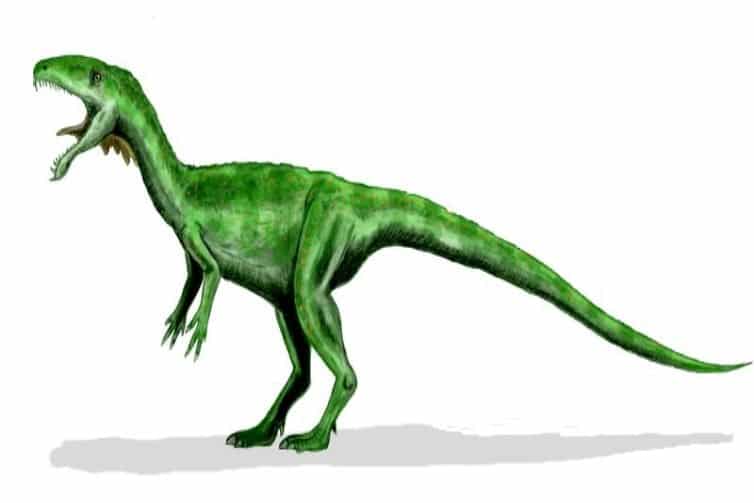
Belonging to the Theropod group, Masiakasaurus is part of the Noasaurid family, with its type species being Masiakasaurus knopfleri. This is the only species in the genus. This classification places it within a lineage of predominantly carnivorous dinosaurs known for their bipedal stance and often formidable hunting skills.
The timeline of Masiakasaurus spans the Maastrichtian Epoch of the Late Cretaceous Period, approximately 72.1 to 66.0 million years ago. This was a time when the world was teeming with diverse life forms, just before the mass extinction event that marked the end of the age of dinosaurs.
Discovery & Fossil Evidence
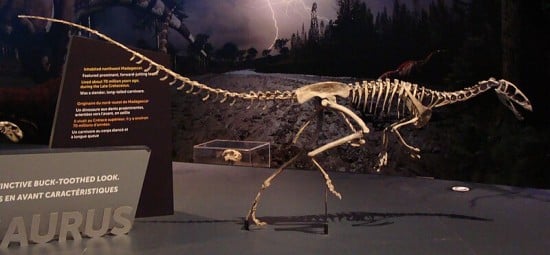
This discovery is a tale of gradual revelation and scientific perseverance. Its remains were first unearthed in the Maevarano Formation in northwestern Madagascar, with the initial description appearing in the prestigious journal Nature in 2001. The initial finds near the village of Berivotra were fragmentary yet significant, comprising around 40% of the skeleton. Among these were several parts of the skull, including the distinctive teeth that would later become a defining feature of the species. Additionally, the humerus (upper arm bone), pubis, hindlimbs, and several vertebrae were collected, providing a glimpse into the anatomy of this intriguing dinosaur.
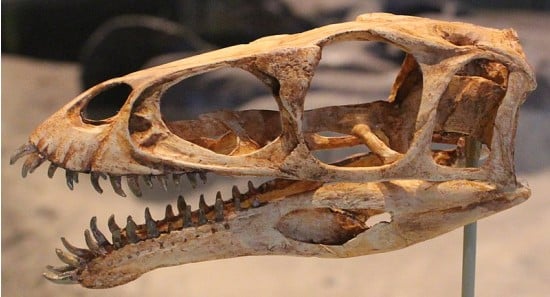
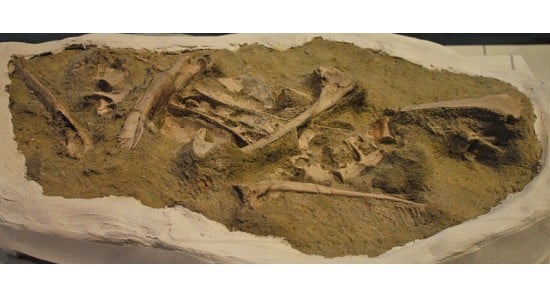
The story of Masiakasaurus didn’t end there. In 2011, several new specimens were described. This new material included the braincase, premaxilla, facial bones, ribcage, portions of the hands and pectoral girdle (coracoid), and much of the cervical and dorsal vertebral column. The significance of these finds cannot be overstated. They not only clarified many aspects of Noasaurid anatomy but also elevated Masiakasaurus to one of the best-known dinosaurs in terms of skeletal understanding. However, it’s worth noting that these new finds, while extensive, did not allow for a detailed study of its evolutionary relationships among Ceratosaurs. With the addition of this new material, our knowledge of the skeleton now encompasses around 65%, painting a more complete picture of this Late Cretaceous inhabitant.
Masiakasaurus Size and Description
This was a small but distinctive theropod, presenting a fascinating deviation from its counterparts. Unlike most theropods, its front teeth jutted forward, not downward. This peculiar dental arrangement hints at a specialized diet that may have included fish and other small prey. The skeletal structure of Masiakasaurus reveals a bipedal stance, with notably shorter forelimbs compared to its hindlimbs, suggesting agility and perhaps a unique hunting strategy.
Size and Weight of Type Species
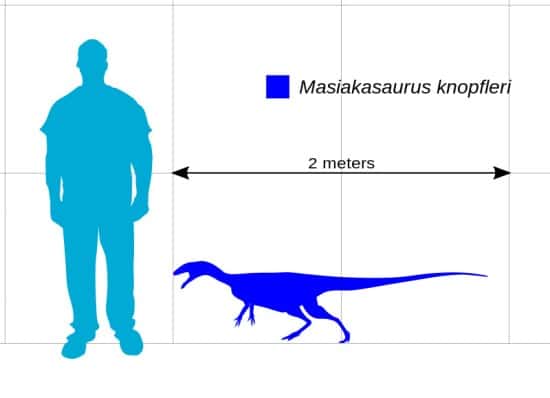
Masiakasaurus knopfleri was relatively petite for a Theropod, measuring approximately 5.9 to 6.9 feet in length and weighing around 44.0 pounds. This size places it in stark contrast to some of the colossal Theropods known from the same era, highlighting the diverse range of body sizes and adaptations within this group of dinosaurs. A 2013 study revealed that Masiakasaurus grew determinately to a small adult size, with a growth rate slower than similar-sized non-avian Theropods but faster than Crocodylians. This slow growth likely offered an advantage in its challenging environment.
The Dinosaur in Detail
This carnivorous dinosaur exhibits intriguing variations within its species. Identified by Carrano and colleagues, there are two forms: the robust morph with thicker bones and pronounced muscle attachments, and the gracile form, more slender with less pronounced muscle attachments. These variations could indicate sexual dimorphism or distinct populations. Additionally, some specimens show possible predation or scavenging marks, suggesting interactions with larger predators like Majungasaurus.
Its teeth are not only arranged in a unique way, but they are also heterdont. This means that the dinosaur has teeth of more than one shape in its jaws. The front teeth are spoon shaped and slightly serrated. The teeth farther back in the mouth are flattened and more serrated. These would have made it a successful hunter and predator of small prey, but were not good at tearing off chunks of meat from larger prey. This has led to theories of a varied diet including small vertebrates and possibly fruits.
Its stiff vertebrae suggest a neck that was not as curved as its relatives. It had longer arms than many of its close relatives, but they were still shortened like most Noasaurids. It had a large sickle-like claw, mostly likely on its hand.
The Ultimate Dino Quiz
Do you want to test your knowledge on dinosaurs? Then try this Ultimate Dino Quiz! Don’t worry if you get some of the answers wrong, and look at it as an opportunity to refresh and improve your knowledge!
Don’t forget to try our other games as well!
Interesting Points about Masiakasaurus
- It displayed two distinct physical forms: the robust and the gracile. These possibly indicate sexual dimorphism or separate populations within the species.
- Its forward-projecting front teeth, a rarity among Theropods, suggest a specialized diet that may have included fish and small prey or even invertebrates and fruits.
- Some specimens bear marks that could be from predation or scavenging, hinting at interactions with larger predators like Majungasaurus.
- It grew determinately to a relatively small size for a theropod, with a unique growth rate that was slower than similar-sized non-avian theropods but faster than Crocodylians.
The Masiakasaurus in its Natural Habitat
This carnivore thrived in an environment that was as dynamic as it was diverse. The Late Cretaceous Period offered a landscape rich in vegetation and varied in geography. This backdrop provided the perfect stage for Masiakasaurus to play out its carnivorous lifestyle.
As a predator, its diet was intrinsically linked to the fauna of its time. Its hunting and feeding habits not only reflect its physical capabilities but also its role in the ecosystem. Whether it was a solitary hunter or moved in groups remains a subject of fascination and study.
Contemporary Dinosaurs
In the prehistoric landscape of what we now know as Madagascar, the Masiakasaurus roamed with a peculiar grace, its forward-jutting teeth a distinctive feature in a world of giants and flyers. This small, feisty carnivore navigated a world where size often dictated the rules of survival. Yet, in this ancient ecosystem, size wasn’t the only player; it was also about wit, speed, and strategy.
Imagine the Masiakasaurus cautiously approaching a watering hole, its eyes darting for signs of danger or opportunity. Nearby, the colossal Majungasaurus, a behemoth predator, looms like a mountain of muscle and scales. This giant easily outweighed the Masiakasaurus by tons and represented a constant threat but also an opportunity. While the Masiakasaurus was no match for the Majungasaurus in a direct confrontation, it could scavenge leftovers from the giant’s kills–a risky but often rewarding strategy.
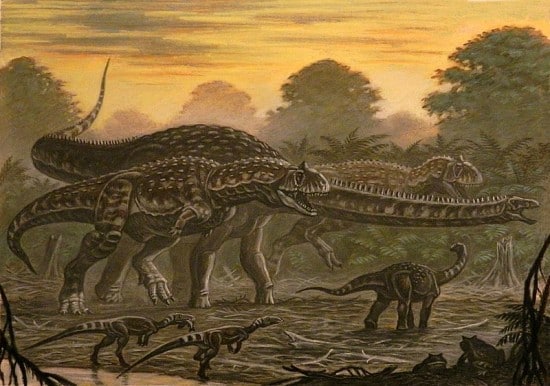
In the trees, the agile Rahonavis flitted from branch to branch. This bird-like dinosaur was roughly half the size of the Masiakasaurus. This aerial acrobat could have been both competitor and prey. Their interactions were likely a high-stakes game of cat and mouse, each using their unique adaptations to outmaneuver the other. Meanwhile, the gentle giant Rapetosaurus, a long-necked herbivore, towered above them all. While it posed no direct threat to the Masiakasaurus, its sheer size and feeding habits could have influenced the availability of vegetation and indirectly impacted the smaller dinosaur’s hunting grounds.
In this dynamic world, our dinosaur was not just a survivor but a testament to the diversity of life. Its interactions with contemporaries like the imposing Majungasaurus, the nimble Rahonavis, and the towering Rapetosaurus painted a vivid picture of an ecosystem where size, speed, and cunning all played roles in prehistoric life.
Frequently Asked Questions
Masiakasaurus translates to “vicious lizard,” a name reflecting its presumed ferocity. It is Malagasy and Greek in origin.
It was discovered in 2001 during an expedition of a team of paleontologists in Madagascar led by Scott Sampson.
This is a carnivorous Theropod from the Noasaurid family.
It lived during the Late Cretaceous Period, specifically the Maastrichtian Epoch.
The first fossil was found in the Maevarano Formation, Madagascar.
It was bipedal, moving on its two hind legs.
Sources
The information in this article is based on various sources, drawing on scientific research, fossil evidence, and expert analysis. The aim is to provide a comprehensive and accurate overview of the Masiakasaurus. However, please be aware that our understanding of dinosaurs and their world is constantly evolving as new discoveries are made.
This article was last fact-checked: Joey Arboleda, 11-03-2023
